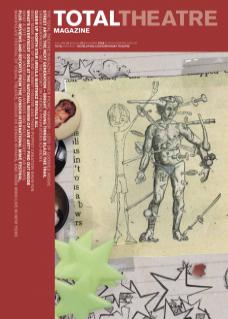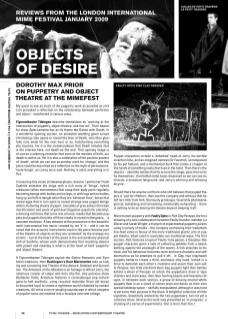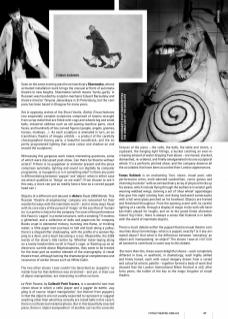My quest to see as much of the puppetry work as possible at LIMF 2009 provoked a reflection on the relationship between performer and object – manifested in various ways.
Figurentheater Tübingen describe themselves as ‘working at the intersection of puppetry, object theatre, and live art’. Their beautiful show Salto.Lamento has as its theme the Dance with Death. In a wonderful opening section, an animated wedding gown turned christening robe opens to reveal the face of Death, who then gleefully runs amok for the next hour or so, transforming everything she touches. For it is the metamorphosis that Death initiates that is the interest here, not death-as-the-end. That opening image is of course a sobering reminder that even at the moment of birth, our death is within us. Yet it is also a celebration of the positive powers of ‘death’, which we can see as another word for ‘change’, and this piece could be described as a reflection on the myth of permanence: ‘toute bouge’, as Lecoq once said. Nothing is solid, everything is in flux.
In enacting this vision of metamorphosis, director / performer Frank Soehnle animates the stage with a rich array of ‘things’: hybrid creatures (often marionettes) that swap their body parts regularly, becoming beings with bodies and no legs, or with legs and no bodies, hung up and left to dangle when they are ‘between lives’; boxes that reveal eggs that in turn open to reveal strange wee puppet beings within; fluttering sheets of paper; cascades of grey ashes (Christian mortification) and pools of gold dust (Egyptian quests for eternity); a dancing red dress that turns into a horse; masks that become puppets and puppets that take off their masks to reveal nothingness… a constant evolution. A key element of the production is the beautiful multi-instrumental live music created by rat ‘n’ X – and it can be noted that the acoustic instruments used in the piece become part of the theatre-of-objects as they are ‘animated’ by the onstage musicians – but at the heart of the piece is the extraordinary physical skill of Soehnle, whose work demonstrates that investing objects with power and meaning is what is at the heart of both ‘puppetry’ and ‘object theatre’.
If Figurentheater Tübingen exploit the Gothic-Romantic and Symbolist traditions, then Buchinger’s Boot Marionettes take us kicking and screaming into Theatre of the Absurd, Dadaism and Surrealism. The Armature of the Absolute is an homage to Alfred Jarry, the notorious creator of vulgar anti-hero Ubu Roi. Like previous show Vestibular Folds, Armature features a carnivalesque pop-culture-gone-to-hell aesthetic, using recycled materials (from old bones to discarded toys) to create a nightmare world inhabited by mutant creatures. All set to a nerve-jangling soundscape in which snippets of popular tunes are mashed into a musique concrete collage.
Puppet characters include a ‘bebodied’ head-of-Jarry, his terrible invention Ubu, and an imagined nemesis Dr Faustroll, accompanied by his pet baboon, and a mechanical duck that comes a cropper at the hands of something nasty that lives in the toilet. Then there’s the objects – absinthe bottles that fly around the stage; pens that write ‘by themselves’; that hellish toilet bowl, dissected so we can see its innards; a miniature fairground; and Jarry’s whirring and whizzing bicycle.
Should there be anyone out there who still believes that puppet theatre is ‘just for children’, then see this company and witness that belief torn limb from limb. Gloriously grotesque, feverishly phantasmagorical, tantalising and tormenting, emotionally exhausting – there is nothing to do on leaving the theatre beyond sleeping it off.
More mutant puppetry with Faulty Optic in Fish Clay Perspex, the first showing of a new collaboration between Faulty founder-member Liz Glover and Sarah Wright; a triptych of experimental puppetry pieces using a variety of media – the company eschewing their trademark live-feed video in favour of the more traditional plastic arts of puppet theatre, albeit used in resolutely non-traditional ways. The first section, Fish, features a typical ‘Faulty’ lone geezer, a Sisyphus-like puppet character given a task of collecting pebbles from a beach, battling against the onslaught of the waves. A fish attaches to his head, and his behaviour becomes more and more dramatic and self-destructive as he attempts to pull it off... in Clay, two (clayhead) puppets battle to create a third, enormous clay head, locked in a drive to demolish each other’s creations and assert their own will. In Perspex, two little stockinet bean-bag puppets fight their battles behind a sheet of Perspex on which the puppeteers draw or tape shelters and staircases, then later hunting beasts and heavenly refuges. In between each section, a group of dancing neutral-white puppets float in on a cloud of cotton wool and dance on their own special tabletop space – skilfully manipulated, although it was hard to perceive their purpose in the show. A delightful collection of little vignettes, beautifully worked by the two puppeteers, but not yet a cohesive show. (And as the work was presented as ‘in-progress’, a showing of a series of experiments, that is more than fine.)
Seen on the same evening was the extraordinary Sharmanka, whose activated installation work brings the unusual artform of automata-theatre to new heights. Sharmanka (which means ‘hurdy-gurdy’ in Russian) was founded by sculptor-mechanic Eduard Bersudsky and theatre director Tatyana Jakovskaya in St Petersburg, but the company has been based in Glasgow for many years.
Set in opposing arches of the Shunt Vaults, Gothic Circus features two exquisitely complex sculptures comprised of towers wrought from scrap metal that are fitted with cogs and wheels big and small, bells, industrial oddities such as old sewing machine parts, clock faces, and hundreds of tiny carved figures (people, angels, gnomes, horses, monkeys…). As each sculpture is animated in turn, an extraordinary theatre of images unfolds – a product of the carefully choreographed moving parts, a beautiful soundtrack, and the expertly programmed lighting that casts colour and shadow on and around the sculptures.
Witnessing this gorgeous work raises interesting questions, some of which were discussed post-show. Can there be theatre without actors? If there is no puppeteer or animator present and the piece comprises automata, lighting and sound run digitally by computer programme, is it puppetry or is it something else? Is there any point in differentiating between ‘puppet’ and ‘object’ when in either case we attach qualities to ‘things’ as we wish? (If we choose to see it this way, a clock can just as readily have a face as a carved puppet head can.)
Objects of a different sort abound in Akhe’s Faust 2360 Words. This Russian ‘theatre-of-engineering’ company are renowned for their wonderful ways with the inanimate world – and in many ways Faust, with its core story of the pursuit of ‘magic’ at the sacrifice of ‘humanity’ is a perfect choice for the company. For most of the performance this Faust is ‘caged’ in a metal structure, with a smoking TV monitor, a glitterball, and a collection of dolls and papercuts for company. Books erupt in elemental trickery, bursting into flame, or trickling water; a little paper man journeys to hell and back along a pulley; there’s a shapeshifter shadowplay, with the profile of a woman flipping to a devil, and a heart becoming a cross. Meanwhile, the 2360 words of the show’s title twitter by. Whether ticker-taping along on a lovely handwritten scroll in Faust’s cage, or flashing up as an electronic surtitle above Mephistopheles, they seem to be treated for the most part as another element of the scenography. A visual theatre treat, although lacking the dramaturgical completeness and resonance of earlier shows such as White Cabin.
The two other shows I saw couldn’t be described as ‘puppetry’ no matter how far that definition was stretched – and yet, in their use of object manipulation, are interesting to reflect on here.
Le Petit Travers, by Collectif Petit Travers, is a wonderful two-man clown show in which a cello player and a juggler do battle. Juggling is of course ‘object manipulation’, but distinct from puppetry in that the objects are not usually expected to represent or suggest anything other than what they actually are (small balls in this case!), there is no theatrical metamorphosis. But in this beautifully enacted piece, there is ‘object manipulation’ of another sort as the concrete fixtures of the piece – the cello, the balls, the table and chairs, a cupboard, the hanging light fittings, a bucket catching an ever-increasing amount of water dripping from above – are moved, stacked, dismantled, re-ordered, and finally amalgamated into one sculptural whole. It’s a perfectly pitched show, and the company deserve all the accolades that have been accorded their London appearances.
Tomas Kubinek is an enchanting ‘fool, clown, visual poet, solo performance artist, multi-talented vaudevillian, comic genius and charming huckster’ with an extraordinary array of physical tricks up his sleeve, which include flying through the audience in aviator garb wearing webbed wings; donning a set of ‘shoe wheel’ appendages that give him eight rotating feet; and doing backward somersaults with a full wine glass perched on his forehead. Objects are framed and fetishised throughout. From the opening scene with its careful lighting of a candle, through a display of magic tricks with silk handkerchiefs played for laughs, and on to the grand finale of aforementioned ‘big tricks’, there is always a sense that Kubinek is in battle with the world of inanimate objects.
There is much debate within the puppet theatre / visual theatre communities about terminology: what is a puppet, exactly? Is it any animated object? And what is the difference between ‘animating’ an object and ‘manipulating’ an object? The shows I saw at LIMF 2009 all seemed to contribute in some way to this debate.
But more than this, these seven delightful shows – each completely different in tone, in aesthetic, in dramaturgy; each highly skilled and finely honed; each with visual imagery drawn from a varied and colourful artistic palette – together formed a body of work that showed that the London International Mime Festival is still, after forty years, the holder of the key to the magic kingdom of visual theatre.


